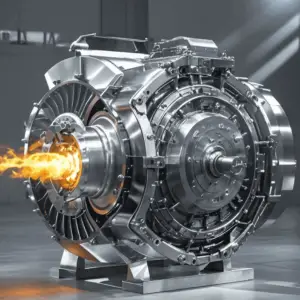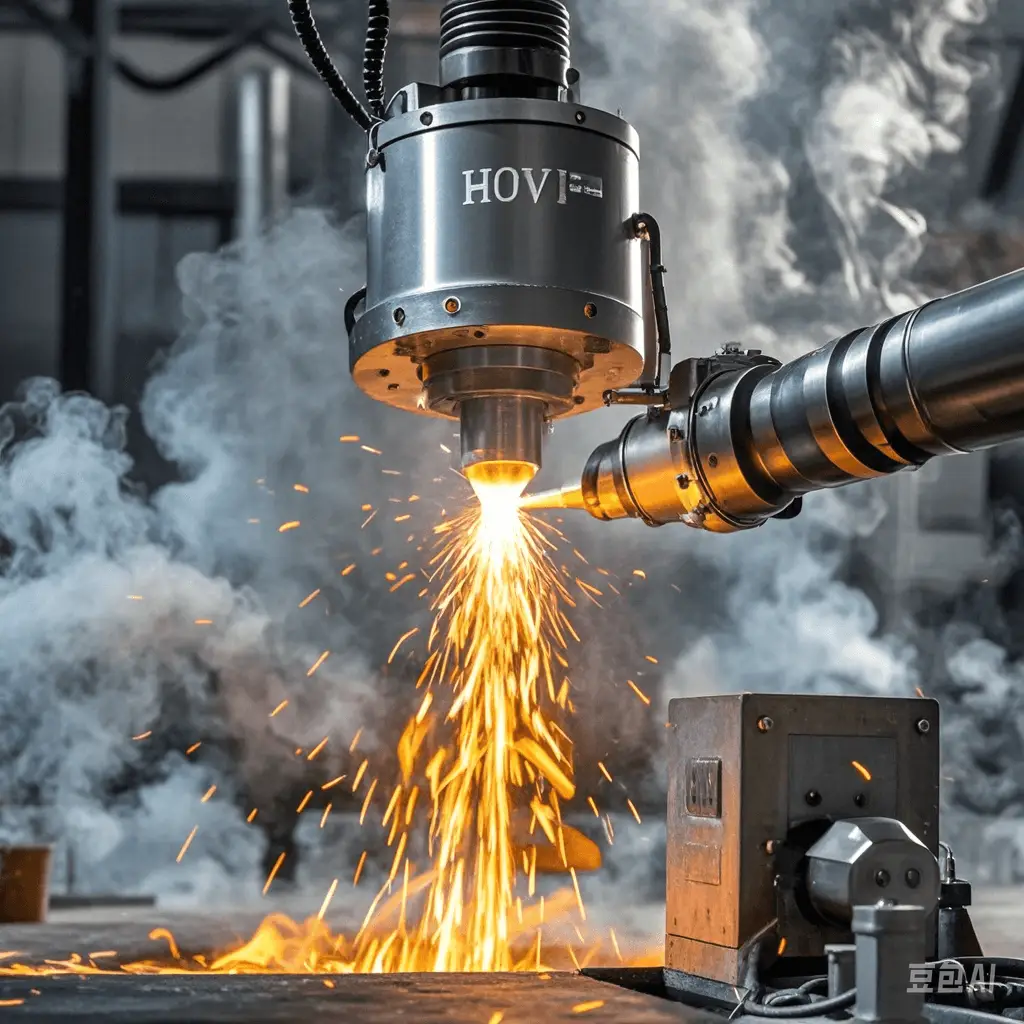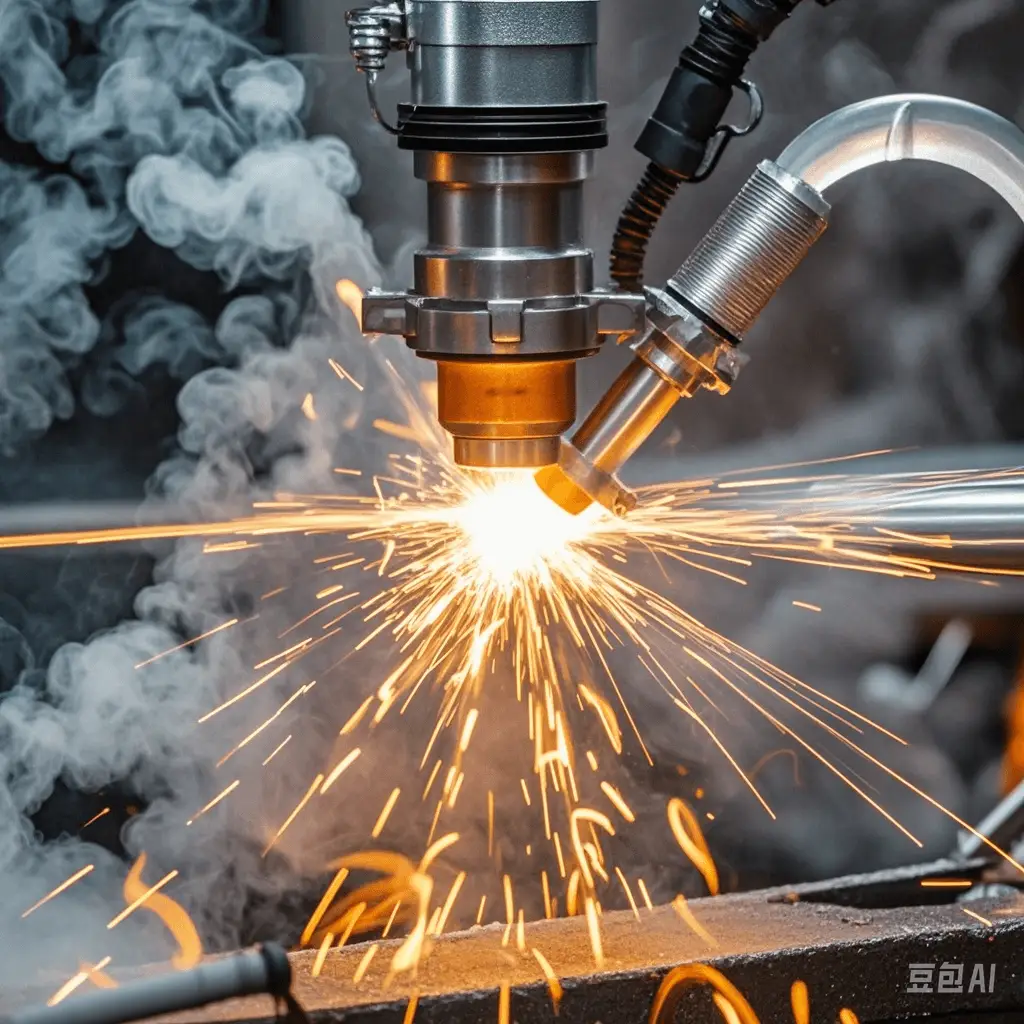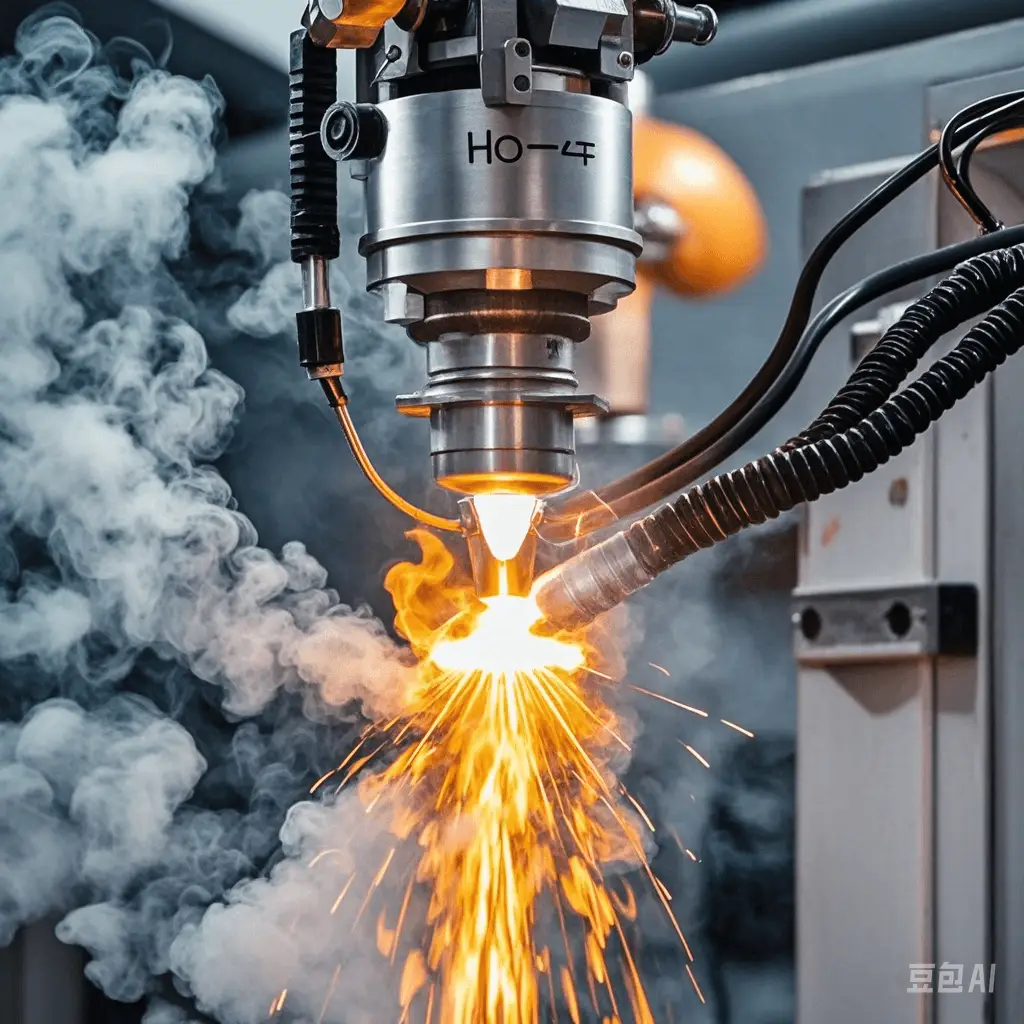Power Generation Industry
In the power generation industry, the reliable operation of equipment is of utmost importance to ensure continuous electricity supply and high energy efficiency. Thermal spray coatings have emerged as a crucial technology with significant potential in this field. They offer a range of benefits, including enhanced protection against wear, corrosion, and high temperatures, which can extend the service life of power generation equipment and improve overall performance. With the continuous development of the power industry and the increasing demand for more efficient and durable equipment, the application prospects of thermal spray coatings are becoming broader and more promising.
I. Types of Thermal Spray Coatings
1. Plasma Spraying

Plasma spraying is a thermal spray process that utilizes a high-temperature plasma jet to melt and accelerate the coating materials towards the substrate. The plasma is generated by passing a gas (such as argon, nitrogen, or a mixture of gases) through an electric arc, creating a highly ionized and extremely hot gaseous state.
One of the notable features of plasma spraying is its ability to handle a wide variety of coating materials, including metals, ceramics, and composites. This versatility allows it to be applied in diverse scenarios within the power generation industry. For instance, in gas turbines, ceramic coatings applied via plasma spraying can withstand the high temperatures generated during operation, providing excellent thermal insulation and protecting the underlying metal components from thermal degradation.
Moreover, plasma spraying can produce coatings with relatively high density and good adhesion to the substrate. The high temperature of the plasma jet ensures that the coating material is thoroughly melted and deposited evenly, resulting in a uniform and durable coating layer. This property is particularly advantageous in power generation equipment where components are subjected to harsh operating conditions, such as the blades of steam turbines that need to endure high rotational speeds and steam erosion while maintaining their mechanical integrity.
2. HVOF (High-Velocity Oxygen Fuel) Spraying
HVOF spraying operates on the principle of mixing a fuel gas (like hydrogen, propane, or kerosene) with oxygen and igniting the mixture in a combustion chamber. The resulting high-velocity gas stream, which can reach supersonic speeds, is used to accelerate the powdered coating material towards the substrate.
The performance characteristics of HVOF coatings are remarkable. Firstly, they exhibit high hardness and excellent wear resistance. In the power generation industry, this is highly valuable for components that experience abrasive wear, such as the shafts and bearings in generators or the moving parts in coal pulverizers. The coatings can significantly reduce wear and extend the maintenance intervals of these components.
Secondly, HVOF coatings have relatively low porosity, which enhances their corrosion resistance. In power plants located in coastal areas or regions with high humidity, where equipment is prone to corrosion due to exposure to salt-laden air or moisture, HVOF-coated surfaces can effectively prevent the ingress of corrosive substances and maintain the integrity of the underlying metal for a longer period. For example, the exterior surfaces of heat exchangers can be protected by HVOF coatings to improve their durability in corrosive environments.
3. Arc Spraying
Arc spraying involves creating an electric arc between two consumable wire electrodes made of the coating material. The intense heat generated by the arc melts the wire tips, and a high-velocity gas jet (usually compressed air) atomizes and propels the molten droplets onto the substrate to form the coating.
The technical key points of arc spraying lie in the control of the arc stability and the atomization process to ensure a consistent and uniform coating quality. It is relatively simple and cost-effective compared to some other thermal spray methods, making it widely applicable in the power generation industry for large-area coating applications.
Arc spraying plays a significant role in protecting power equipment. For example, in boilers, the inner walls are constantly exposed to the erosive action of flue gases and the corrosive effects of combustion by-products. Arc-sprayed coatings can act as a protective barrier, reducing the rate of metal degradation and enhancing the overall lifespan of the boiler structure. Additionally, for the structural supports and frames in power plants that are subject to environmental corrosion, arc spraying can provide an economical yet effective corrosion protection solution.
4. Other Types of Spraying
There are also several other thermal spray techniques that, although less commonly used in the power generation industry, still possess certain potential. For instance, flame spraying uses a combustion flame to melt the coating material and deposit it on the substrate. It is relatively simple and can be applied for some less demanding coating tasks or for repairing small areas of damaged coatings.
Cold spraying is another emerging technique that does not rely on melting the coating material but accelerates solid particles to high velocities using a supersonic gas jet. These particles then deform and bond with the substrate upon impact. While still in the early stages of application in the power industry, it shows promise for depositing certain materials that are sensitive to high-temperature melting or for creating coatings with unique microstructures and properties.
II. Applications of Thermal Spray Coatings in the Power Generation Industry
1. Protection of Power Generation Equipment
 Power generation equipment, such as generators, steam turbines, and gas turbines, operates under extremely harsh conditions. Generators are subject to mechanical stress, electrical erosion, and heat generation during operation. Thermal spray coatings can be applied to critical components like generator rotors and stator windings to provide insulation against electrical breakdown and protection against wear caused by friction between moving parts.
Power generation equipment, such as generators, steam turbines, and gas turbines, operates under extremely harsh conditions. Generators are subject to mechanical stress, electrical erosion, and heat generation during operation. Thermal spray coatings can be applied to critical components like generator rotors and stator windings to provide insulation against electrical breakdown and protection against wear caused by friction between moving parts.
Steam turbines, on the other hand, face challenges from high-temperature steam, high rotational speeds, and potential corrosion from the water-steam cycle. Coatings on turbine blades and casings can improve their resistance to thermal fatigue, erosion by steam particles, and corrosion. By forming a protective layer, the coatings help maintain the mechanical strength and performance of the turbine components, reducing the risk of failure and extending their operational lifespan.
Gas turbines operate at even higher temperatures, often exceeding the melting points of common metals. Ceramic-based thermal spray coatings are used to insulate the hot sections of gas turbines, enabling them to operate at higher efficiencies while protecting the underlying metal superalloys from excessive heat damage. This not only improves the performance of the gas turbine but also reduces the frequency of maintenance and replacement of expensive components.
2. Anti-corrosion and Anti-wear Applications
Corrosion is a major concern in the power generation industry, especially in power plants near the sea or in areas with high pollution levels. Thermal spray coatings, particularly those with high corrosion resistance like zinc, aluminum, or their alloys, can be applied to the exterior surfaces of equipment such as cooling towers, pipelines, and storage tanks. These coatings act as sacrificial anodes, corroding preferentially to protect the underlying metal substrate from oxidation and deterioration caused by environmental factors.
In terms of wear resistance, many power generation components experience abrasive or erosive wear due to the movement of fluids, solids, or mechanical interactions. For example, in coal-fired power plants, the pulverizers that grind coal into fine powder are subject to severe abrasive wear. HVOF or arc-sprayed coatings with high hardness materials like tungsten carbide can be applied to the grinding surfaces of these pulverizers to significantly reduce wear and increase their service life. Similarly, in hydroelectric power plants, the turbine blades that interact with flowing water can be coated to resist erosion caused by sediment particles in the water.
3. Improving Energy Efficiency
Thermal spray coatings can also contribute to improving energy efficiency in the power generation industry. In heat exchangers, for instance, coatings with high thermal conductivity can be applied to enhance heat transfer between the hot and cold fluids. This allows for more efficient utilization of the heat energy, reducing the energy consumption required to maintain the desired temperature differences in the power plant’s thermal cycles.
Moreover, by improving the surface properties of components such as turbine blades and compressor blades, coatings can reduce friction losses. A smoother and more aerodynamic surface achieved through appropriate thermal spray coatings can result in lower energy losses during the rotation of these components, thereby increasing the overall efficiency of the power generation process. For example, in wind turbines, which are an important part of the renewable energy sector in power generation, coatings can be applied to the blades to optimize their aerodynamic performance and improve energy capture efficiency.
III. Market Analysis of Thermal Spray Equipment
1. Global Market Landscape
 The global thermal spray equipment market is dominated by several major manufacturers, including companies that specialize in advanced plasma spraying systems, HVOF spraying equipment, and arc spraying devices. These manufacturers have established strong brand reputations and technological advantages, often holding significant market shares in different regions.
The global thermal spray equipment market is dominated by several major manufacturers, including companies that specialize in advanced plasma spraying systems, HVOF spraying equipment, and arc spraying devices. These manufacturers have established strong brand reputations and technological advantages, often holding significant market shares in different regions.
In recent years, the market has witnessed a steady growth trend, driven by the increasing demand for high-performance coatings in industries such as aerospace, automotive, and, of course, power generation. Technological advancements in thermal spray equipment, such as the development of more precise and efficient spraying processes, improved nozzle designs, and enhanced control systems, have also contributed to the expansion of the market.
However, the global market is also characterized by intense competition, with manufacturers constantly striving to innovate and differentiate their products to gain a competitive edge. There is a growing trend towards the integration of automation and digitalization in thermal spray equipment, enabling more precise control of coating parameters and higher quality coatings, which is expected to shape the future direction of the market.
2. Current Situation of the Chinese Market
In China, the thermal spray equipment market has experienced rapid development in line with the country’s booming industrial growth, especially in the power generation, petrochemical, and manufacturing sectors. There is a significant demand for thermal spray equipment to meet the coating requirements of various industrial applications.
The Chinese market is characterized by a diverse range of players, including both domestic manufacturers and international brands. Domestic manufacturers have been making efforts to improve their technological capabilities and product quality to compete with international counterparts. They have achieved certain success in developing cost-effective thermal spray equipment suitable for the domestic market’s needs.
Moreover, with the Chinese government’s increasing emphasis on energy conservation, environmental protection, and the upgrading of industrial equipment, the potential for the application of thermal spray coatings in the power generation industry is expected to further expand. This will drive the continuous growth of the thermal spray equipment market in China, presenting both opportunities and challenges for market participants.
IV. Challenges Faced by Thermal Spray Coatings
1. Technical Challenges
One of the main technical challenges in the application of thermal spray coatings in the power generation industry is ensuring strong adhesion between the coating and the substrate. In harsh operating conditions, such as high temperatures, rapid temperature changes, and mechanical vibrations, coatings may peel off or delaminate from the substrate, leading to a loss of protection and performance. Improving the bonding strength requires precise control of spraying parameters, proper surface preparation of the substrate, and the development of advanced bonding agents or pretreatment techniques.
Another technical issue is the uniformity and porosity of the coatings. Non-uniform coatings can result in inconsistent protection, with some areas being more vulnerable to wear or corrosion than others. High porosity in coatings can reduce their density and mechanical properties, as well as increase the likelihood of corrosive substances penetrating through the coating. Achieving low-porosity and uniform coatings demands advanced spraying technologies and strict quality control during the coating process.
2. Cost Factors
The cost associated with thermal spray coatings can be a significant barrier to their wider application in the power generation industry. The initial investment in thermal spray equipment, including the purchase of spraying systems, consumables (such as coating powders and gases), and the cost of maintenance and operation, can be quite high. Additionally, the application process may require specialized labor with technical expertise, which further adds to the overall cost.
Compared to traditional coating or protection methods, the cost-benefit analysis of thermal spray coatings needs to be carefully evaluated. Although they offer long-term benefits in terms of equipment protection and improved performance, 说服 power plant operators and decision-makers to adopt thermal spray coatings requires demonstrating clear economic advantages over the lifespan of the equipment.
V. Future Development Trends of Thermal Spray Coatings
1. Technological Innovation Directions
In the future, there will be continuous efforts in developing new coating materials for thermal spray applications. Nanomaterials, for example, hold great promise due to their unique physical and chemical properties. Nanostructured coatings can exhibit enhanced hardness, wear resistance, and corrosion resistance, which could revolutionize the protection of power generation equipment.
The improvement of spraying processes is also an important aspect. Hybrid spraying techniques that combine different thermal spray methods or integrate thermal spray with other surface treatment technologies are expected to emerge. This could allow for the creation of coatings with even more complex and tailored properties to meet the specific requirements of different power generation applications.
Furthermore, advancements in in-situ monitoring and control technologies during the spraying process will enable real-time adjustment of spraying parameters to ensure coating quality. This will involve the use of sensors to monitor parameters such as temperature, particle velocity, and coating thickness, providing feedback for precise control of the spraying operation.
2. Market Prospect Forecast
Looking ahead, the market for thermal spray coatings in the power generation industry is expected to continue growing. With the increasing focus on renewable energy sources and the upgrading of traditional power generation equipment to meet more stringent environmental and efficiency requirements, the demand for high-performance coatings will rise.
In the field of renewable energy, such as solar power plants and wind farms, thermal spray coatings can play a role in protecting components from environmental degradation and improving their performance. For traditional power plants, the need to extend the service life of existing equipment and improve energy efficiency will drive the adoption of thermal spray coatings.
However, the market growth will also depend on overcoming the technical and cost challenges mentioned earlier. Manufacturers and researchers will need to work together to develop more cost-effective and reliable coating solutions to fully realize the potential of thermal spray coatings in the power generation industry.
VI. Conclusion
Thermal spray coatings have demonstrated significant value in the power generation industry through their ability to protect equipment, combat corrosion and wear, and improve energy efficiency. Despite facing technical and cost challenges, the continuous technological innovations and promising market prospects indicate a bright future for their application in this sector. As the power industry continues to evolve and strive for higher performance and sustainability, thermal spray coatings will undoubtedly play an increasingly important role in ensuring the reliable operation and longevity of power generation equipment. It is essential for industry stakeholders, including manufacturers, researchers, and power plant operators, to collaborate closely to further develop and optimize thermal spray coating technologies and drive their widespread adoption in the power generation industry.





